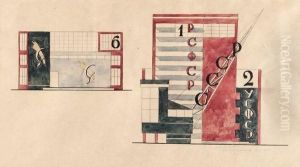Ilya Golosov Paintings
Ilya Alexandrovich Golosov was a notable Russian architect associated with the Constructivist movement. Born on June 30, 1883, in Moscow, Russia, he was part of an artistic family, with his brother Panteleimon Golosov also becoming a prominent architect. Ilya Golosov studied at the Moscow School of Painting, Sculpture and Architecture, where he honed his skills before the Russian Revolution altered the cultural and political landscape of the country.
In the early years of his career, Golosov was influenced by neoclassicism and the Russian Revival style. However, his architectural vision underwent significant changes following the 1917 Revolution. He became an active participant in the avant-garde movement, embracing Constructivism, which sought to reflect the modern industrial age with functional, innovative, and abstract designs.
During the 1920s, Golosov's work became synonymous with the dynamism and idealism of the Constructivist movement. One of his most celebrated works from this period is the Zuev Workers' Club in Moscow, completed in 1927-1929. The club is known for its bold geometric forms and innovative use of space, which was designed to serve the social and cultural needs of the working class.
However, by the end of the 1920s, Constructivism started to fall out of favor with the Soviet authorities, who began to promote a more conservative, monumental style known as Socialist Realism. Golosov adapted to these changes to some extent and continued to work on various projects, including residential buildings and urban planning schemes.
Golosov's contributions to architecture were significant during his lifetime, but his work, like many of his contemporaries', was later overshadowed by the state-imposed architectural styles. He died on January 7, 1945, in Moscow. Although his career was curtailed by changing political winds, his early Constructivist works remain celebrated examples of early 20th-century avant-garde architecture, and they have been studied and admired for their innovative approach to design and function.
